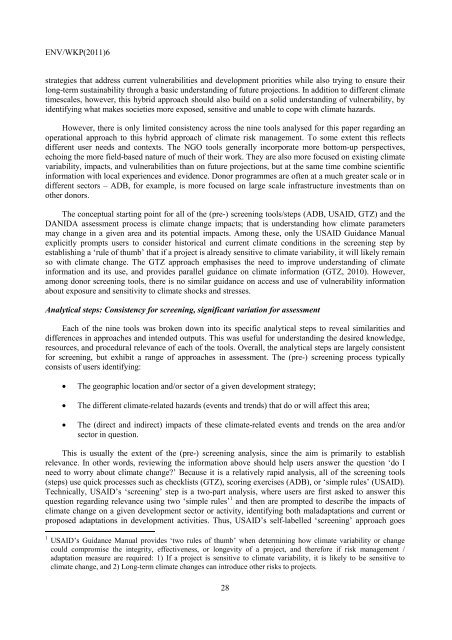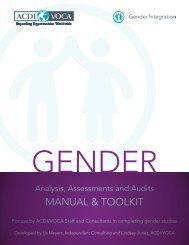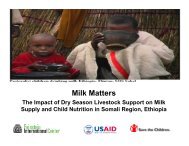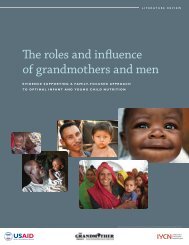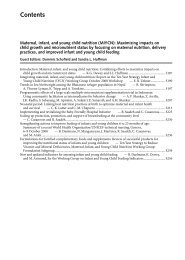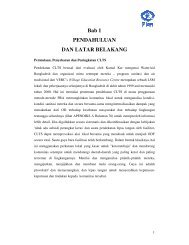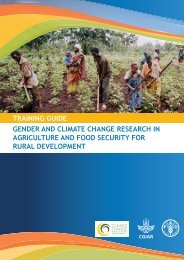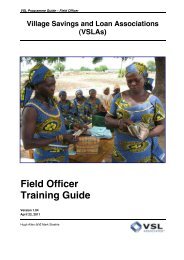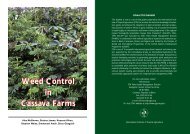Harmonising Climate Risk Management - International Institute for ...
Harmonising Climate Risk Management - International Institute for ...
Harmonising Climate Risk Management - International Institute for ...
- No tags were found...
You also want an ePaper? Increase the reach of your titles
YUMPU automatically turns print PDFs into web optimized ePapers that Google loves.
ENV/WKP(2011)6strategies that address current vulnerabilities and development priorities while also trying to ensure theirlong-term sustainability through a basic understanding of future projections. In addition to different climatetimescales, however, this hybrid approach should also build on a solid understanding of vulnerability, byidentifying what makes societies more exposed, sensitive and unable to cope with climate hazards.However, there is only limited consistency across the nine tools analysed <strong>for</strong> this paper regarding anoperational approach to this hybrid approach of climate risk management. To some extent this reflectsdifferent user needs and contexts. The NGO tools generally incorporate more bottom-up perspectives,echoing the more field-based nature of much of their work. They are also more focused on existing climatevariability, impacts, and vulnerabilities than on future projections, but at the same time combine scientificin<strong>for</strong>mation with local experiences and evidence. Donor programmes are often at a much greater scale or indifferent sectors – ADB, <strong>for</strong> example, is more focused on large scale infrastructure investments than onother donors.The conceptual starting point <strong>for</strong> all of the (pre-) screening tools/steps (ADB, USAID, GTZ) and theDANIDA assessment process is climate change impacts; that is understanding how climate parametersmay change in a given area and its potential impacts. Among these, only the USAID Guidance Manualexplicitly prompts users to consider historical and current climate conditions in the screening step byestablishing a ‘rule of thumb’ that if a project is already sensitive to climate variability, it will likely remainso with climate change. The GTZ approach emphasises the need to improve understanding of climatein<strong>for</strong>mation and its use, and provides parallel guidance on climate in<strong>for</strong>mation (GTZ, 2010). However,among donor screening tools, there is no similar guidance on access and use of vulnerability in<strong>for</strong>mationabout exposure and sensitivity to climate shocks and stresses.Analytical steps: Consistency <strong>for</strong> screening, significant variation <strong>for</strong> assessmentEach of the nine tools was broken down into its specific analytical steps to reveal similarities anddifferences in approaches and intended outputs. This was useful <strong>for</strong> understanding the desired knowledge,resources, and procedural relevance of each of the tools. Overall, the analytical steps are largely consistent<strong>for</strong> screening, but exhibit a range of approaches in assessment. The (pre-) screening process typicallyconsists of users identifying:• The geographic location and/or sector of a given development strategy;• The different climate-related hazards (events and trends) that do or will affect this area;• The (direct and indirect) impacts of these climate-related events and trends on the area and/orsector in question.This is usually the extent of the (pre-) screening analysis, since the aim is primarily to establishrelevance. In other words, reviewing the in<strong>for</strong>mation above should help users answer the question ‘do Ineed to worry about climate change?’ Because it is a relatively rapid analysis, all of the screening tools(steps) use quick processes such as checklists (GTZ), scoring exercises (ADB), or ‘simple rules’ (USAID).Technically, USAID’s ‘screening’ step is a two-part analysis, where users are first asked to answer thisquestion regarding relevance using two ‘simple rules’ 1 and then are prompted to describe the impacts ofclimate change on a given development sector or activity, identifying both maladaptations and current orproposed adaptations in development activities. Thus, USAID’s self-labelled ‘screening’ approach goes1 USAID’s Guidance Manual provides ‘two rules of thumb’ when determining how climate variability or changecould compromise the integrity, effectiveness, or longevity of a project, and there<strong>for</strong>e if risk management /adaptation measure are required: 1) If a project is sensitive to climate variability, it is likely to be sensitive toclimate change, and 2) Long-term climate changes can introduce other risks to projects.28


